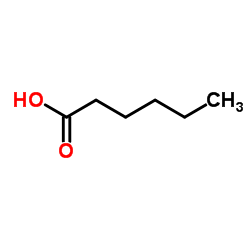1-Hexanoic acid

1-Hexanoic acid structure
|
Common Name | 1-Hexanoic acid | ||
|---|---|---|---|---|
| CAS Number | 142-62-1 | Molecular Weight | 116.158 | |
| Density | 1.0±0.1 g/cm3 | Boiling Point | 204.6±3.0 °C at 760 mmHg | |
| Molecular Formula | C6H12O2 | Melting Point | −4 °C(lit.) | |
| MSDS | Chinese USA | Flash Point | 104.4±0.0 °C | |
| Symbol |

GHS05 |
Signal Word | Danger | |
|
Combined effects of nutrients and temperature on the production of fermentative aromas by Saccharomyces cerevisiae during wine fermentation.
Appl. Microbiol. Biotechnol. 99(5) , 2291-304, (2015) Volatile compounds produced by yeast during fermentation greatly influence the organoleptic qualities of wine. We developed a model to predict the combined effects of initial nitrogen and phytosterol content and fermentation temperature on the production of v... |
|
|
Novel Antibodies Reactive with Sialyl Lewis X in Both Humans and Mice Define Its Critical Role in Leukocyte Trafficking and Contact Hypersensitivity Responses.
J. Biol. Chem. 290 , 15313-26, (2015) Sialyl Lewis X (sLe(x)) antigen functions as a common carbohydrate determinant recognized by all three members of the selectin family. However, its expression and function in mice remain undefined due to the poor reactivity of conventional anti-sLe(x) monoclo... |
|
|
Olfactometry Profiles and Quantitation of Volatile Sulfur Compounds of Swiss Tilsit Cheeses.
J. Agric. Food Chem. 63 , 7511-21, (2015) To establish the odor profiles of three differently fabricated commercial Swiss Tilsit cheeses, analyses were conducted using headspace solid-phase microextraction gas chromatography-mass spectrometry/pulsed flame photometric detection and gas chromatography-... |
|
|
Molecular self assembly of mixed comb-like dextran surfactant polymers for SPR virus detection.
Carbohydr. Polym. 112 , 440-7, (2014) The synthesis of two comb-like dextran surfactant polymers, that are different in their dextran molecular weight (MW) distribution and the presence of carboxylic groups, and their characterization are reported. A bimodal carboxylic dextran surfactant polymer ... |
|
|
Physiology and pathophysiology of organic acids in cerebrospinal fluid.
J. Inherit. Metab. Dis. 16(4) , 648-69, (1993) Concentrations of organic acids in cerebrospinal fluid (CSF) appear to be directly dependent upon their rate of production in the brain. There is evidence that the net release of short-chain monocarboxylic acids from the brain is a major route for removing th... |
|
|
Calculating virtual log P in the alkane/water system (log P(N)(alk)) and its derived parameters deltalog P(N)(oct-alk) and log D(pH)(alk).
J. Med. Chem. 48 , 3269-79, (2005) Growing interest in the use of both the logarithm of the partition coefficient of the neutral species in the alkane/water system (log P(N)(alk)) and the difference between log P(N)(oct) (the logarithm of the partition coefficient of the neutral species in the... |
|
|
Volatile Compounds from Grape Skin, Juice and Wine from Five Interspecific Hybrid Grape Cultivars Grown in Québec (Canada) for Wine Production.
Molecules 20 , 10980-1016, (2015) Developed from crosses between Vitis vinifera and North American Vitis species, interspecific hybrid grape varieties are becoming economically significant in northern areas, where they are now extensively grown for wine production. However, the varietal diffe... |
|
|
Automated screening of urine samples for carbohydrates, organic and amino acids after treatment with urease.
J. Chromatogr. A. 562(1-2) , 125-38, (1991) Eighty-five clinical urine samples and nineteen urine samples previously found by other laboratories to suggest genetic metabolic defects were prepared for trimethylsilylation by treatment with urease, followed by azeotropic dehydration. The "Target Analyte S... |
|
|
Structural variation governs substrate specificity for organic anion transporter (OAT) homologs. Potential remote sensing by OAT family members.
J. Biol. Chem. 282 , 23841-53, (2007) Organic anion transporters (OATs, SLC22) interact with a remarkably diverse array of endogenous and exogenous organic anions. However, little is known about the structural features that determine their substrate selectivity. We examined the substrate binding ... |
|
|
Protic ionic liquids (PILs) nanostructure and physicochemical properties: development of high-throughput methodology for PIL creation and property screens.
Phys. Chem. Chem. Phys. 17(4) , 2357-65, (2014) A high-throughput approach was developed in order to prepare and dry a series of protic ionic liquids (PILs) from 48 Brønsted acid-base combinations. Many combinations comprised an alkyl carboxylic acid paired with an alkyl amine. Visual screens were develope... |